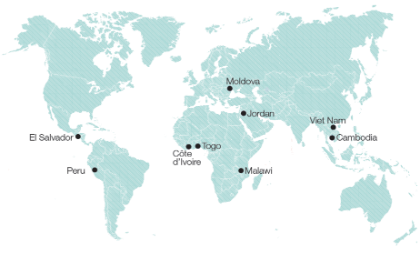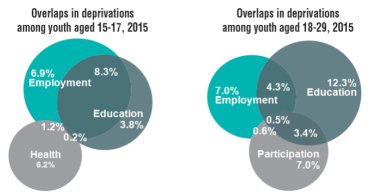Inclusive societies and development
Youth well-being policy review of Viet Nam: A 60 seconds guide
 |
What is the Youth Well-being Policy Review of Viet Nam?
|
The Youth Well-being Policy Review of Viet Nam provides a full diagnosis on the situation of youth in Viet Nam. The analysis uses a multidimensional approach to look at various dimensions of well-being affecting youth. The review includes:
|
|
How's life for young Vietnamese?
|
Young Vietnamese are healthier and better educated than previous generations. Despite this progress, Vietnamese youth face multiple challenges. Employment remains the biggest challenge. Skills mismatch affects close to half of working youth, with 43.5% in jobs that did not match their qualifi cations in 2014. Informality remains the norm for most young workers, with 75% having no social insurance of any kind, and nearly half of them engaged with unwritten contracts. Young Vietnamese may be better educated, but for many, career aspirations are left unmet. Vocational education and training (VET) can help narrow the skills gaps. For long VET has had a bad reputation as a path towards low-skilled jobs, with little chance of career progress. This is slowly changing thanks in part to the State’s efforts to better communicate about the value of VET and improve access to VET in rural areas. VET graduates are having positive employment outcomes. Viet Nam made great progress towards universal primary and lower secondary education. Yet, enrolment gaps in upper-secondary school persist, especially for ethnic minorities and in certain provinces. Among youth aged 25-29, only 31% had completed upper-secondary education or higher. This has signifi cant implications for youth employability. Sexual and reproductive health (SRH) remains a concern for adolescent girls and young women, who are vulnerable to early pregnancy, unsafe abortion, sexually transmitted infections and HIV/AIDS. Adolescent (15-19) fertility rate is higher than in many other Asian countries and affects ethnic minorities, low educated, poor and rural young girls most. Social norms still discourage young women and men, and even married couples, from seeking SRH services or counselling. Vietnamese youth have a high level of trust in public authorities. Youth participation takes place mostly in the form of volunteering in political or civic organisations. Participation in policy making is low and varies widely depending on socio-economic background, with the better educated youth more interested and engaged in politics and civic activities.
|
|
Did you know?
Among the tertiary educated, 92% want to get high-skilled jobs, but only 70% actually succeed. At the same time, 7.6% of young people aspire to get medium-skilled jobs, but in reality 30% end up in this job category.
|
|
Did you know...?
About 9% of young people (15-29) suffer from deprivation in multiple dimensions of well-being simultaneously. Younger youth (15-17) have overlapping deprivations in employment and education, while older youth (19-29) suffer from poor education and employment outcomes, but not necessarily at the same time. The Youth-Multidimensional Deprivation Indicator (Y-MDI) measures the share of young people who are affected by multiple deprivations simultaneously. |
|
|
How to address those challenges?
|
The youth agenda in Viet Nam is gaining ground in policy debates: the enactment of the Youth Law in 2005 marked a major step towards fulfi lling the rights of young people, and the Vietnamese Youth Development Strategy 2011-2020 provides a multi-sectoral roadmap for youth well-being. However, structural and financial constraints remain big challenges.
|
What can the government do?
|
In terms of policies, a multi-sectoral approach is key to improving youth well-being: Health
Education
Employment
|
Related Documents

